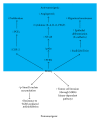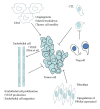Anti- and Protumorigenic Effects of PPARγ in Lung Cancer Progression: A Double-Edged Sword
- PMID: 22934105
- PMCID: PMC3425863
- DOI: 10.1155/2012/362085
Anti- and Protumorigenic Effects of PPARγ in Lung Cancer Progression: A Double-Edged Sword
Abstract
Peroxisome proliferator-activated receptor-γ (PPARγ) is a member of the nuclear receptor superfamily of ligand-activated transcription factors that plays an important role in the control of gene expression linked to a variety of physiological processes, including cancer. Ligands for PPARγ include naturally occurring fatty acids and the thiazolidinedione class of antidiabetic drugs. Activation of PPARγ in a variety of cancer cells leads to inhibition of growth, decreased invasiveness, reduced production of proinflammatory cytokines, and promotion of a more differentiated phenotype. However, systemic activation of PPARγ has been reported to be protumorigenic in some in vitro systems and in vivo models. Here, we review the available data that implicate PPARγ in lung carcinogenesis and highlight the challenges of targeting PPARγ in lung cancer treatments.
Figures


Similar articles
-
Targeting PPARγ Signaling Cascade for the Prevention and Treatment of Prostate Cancer.PPAR Res. 2012;2012:968040. doi: 10.1155/2012/968040. Epub 2012 Nov 14. PPAR Res. 2012. PMID: 23213321 Free PMC article.
-
The Role of PPARγ Ligands in Breast Cancer: From Basic Research to Clinical Studies.Cancers (Basel). 2020 Sep 14;12(9):2623. doi: 10.3390/cancers12092623. Cancers (Basel). 2020. PMID: 32937951 Free PMC article. Review.
-
Role of Peroxisome Proliferator-Activated Receptor Gamma (PPARγ) in Different Disease States: Recent Updates.Curr Med Chem. 2021;28(16):3193-3215. doi: 10.2174/0929867327666200716113136. Curr Med Chem. 2021. PMID: 32674727 Review.
-
The Role of PPARgamma in the Cyclooxygenase Pathway in Lung Cancer.PPAR Res. 2008;2008:790568. doi: 10.1155/2008/790568. PPAR Res. 2008. PMID: 18769553 Free PMC article.
-
Anticancer actions of PPARγ ligands: Current state and future perspectives in human lung cancer.World J Biol Chem. 2010 Mar 26;1(3):31-40. doi: 10.4331/wjbc.v1.i3.31. World J Biol Chem. 2010. PMID: 21537367 Free PMC article.
Cited by
-
Peroxisome proliferator activated receptor γ protein expression is asymmetrically distributed in primary lung tumor and metastatic to lung osteosarcoma samples and does not correlate with gene methylation.BMC Vet Res. 2015 Sep 4;11:230. doi: 10.1186/s12917-015-0547-x. BMC Vet Res. 2015. PMID: 26334880 Free PMC article.
-
Targeting PPARγ Signaling Cascade for the Prevention and Treatment of Prostate Cancer.PPAR Res. 2012;2012:968040. doi: 10.1155/2012/968040. Epub 2012 Nov 14. PPAR Res. 2012. PMID: 23213321 Free PMC article.
-
PPARG Could Work as a Valid Therapeutic Strategy for the Treatment of Lung Squamous Cell Carcinoma.PPAR Res. 2020 Jun 1;2020:2510951. doi: 10.1155/2020/2510951. eCollection 2020. PPAR Res. 2020. PMID: 32565768 Free PMC article.
References
-
- Global Cancer Facts & Figures 2007. Atlanta, Ga, USA: American Cancer Society; 2007.
-
- SEER Cancer Statistics Review, 1975–2008. 2011, http://seer.cancer.gov/csr/1975_2008/
-
- Weis SM, Cheresh DA. Tumor angiogenesis: molecular pathways and therapeutic targets. Nature Medicine. 2011;17(11):1359–1370. - PubMed
Grants and funding
LinkOut - more resources
Full Text Sources

